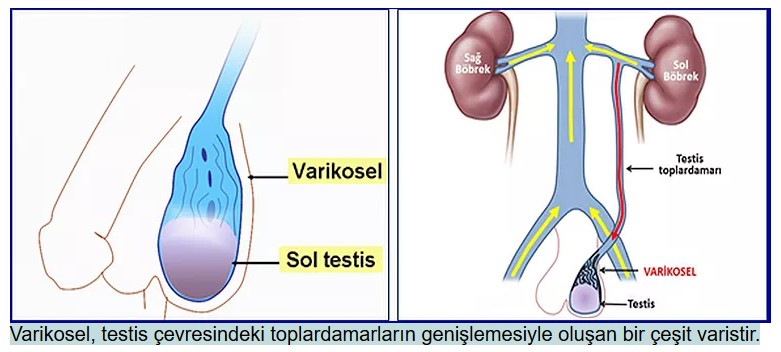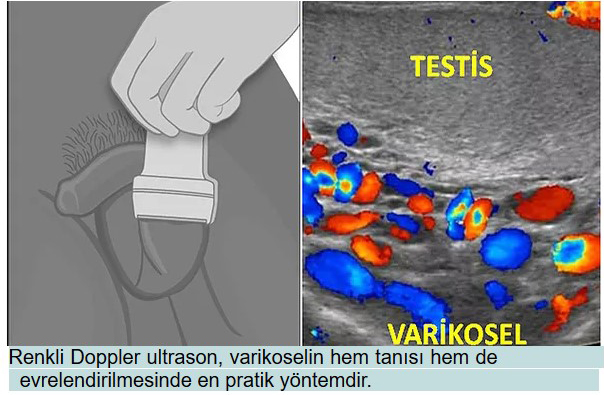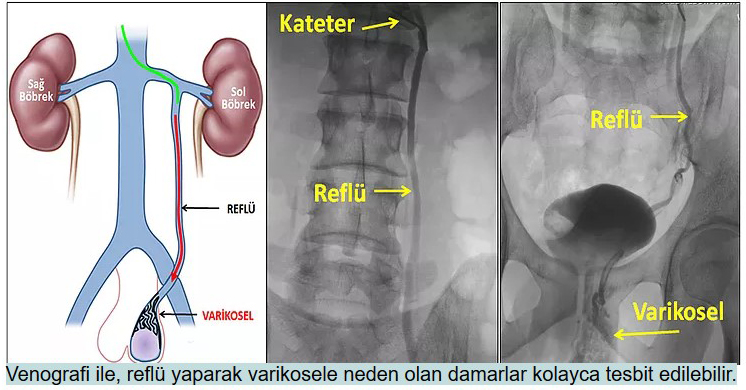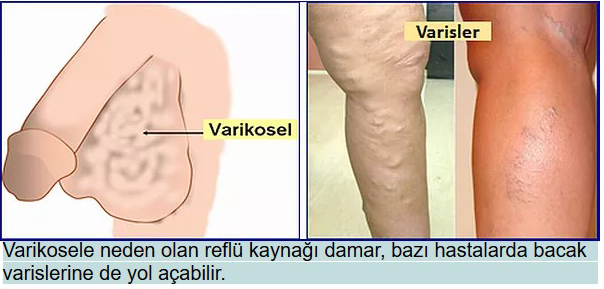Varicocele is a type of varicose that occurs around the testicle. It occurs in approximately 10% of young men and is most commonly diagnosed between the ages of 15 and 30. The cause of varicocele is valve insufficiency in testicular veins. The veins of the testis are found in the form of a network around the testis. This network then empties into the renal vein on the left and the main vein in the abdomen on the right as a single vein. In some patients, valve failure develops in the testicular vein over time, and blood begins to flow backwards and in the opposite direction (reflux), just like in patients with varicose veins in the legs. This blood accumulates in the veins around the testicle, causing this thin vein network to expand over time. This expanding vein network is also called “varicocele”.

What are the symptoms of varicocele?
Varicocele does not cause any complaints in some patients. If the sperm examination is normal in these patients, no treatment may be required. In some patients, varicocele can lead to serious health problems, up to infertility. The most common symptoms in patients with varicocele are:
- Pain: In varicocele, significant pain can be seen in the testis as a result of the pressure created by the dirty blood accumulating in the veins around the testis. Infertility problems: As a result of the venous blood accumulating in the varicocele, increasing the temperature in the testis, patients with varicocele may develop a decrease in sperm count, slowing of sperm movements and deformities in sperm. One study found that 40% of men with infertility problems had varicoceles. In such patients, a significant increase in sperm count and quality has been found in 50-70% of the cases with the treatment of varicocele with embolization or surgery.
- Atrophy: In varicocele, a chronic malnutrition occurs as a result of the accumulation of dirty vein blood in the testis and shrinkage (atrophy) may develop in the testis. If such cases are recognized early and varicocele is treated, the testicle can return to its normal size.
- Visual disturbance: Some varicoceles may be large enough to be easily seen when viewed from the opposite side while the person is standing. This may lead to psychological problems in patients.
- Leg varicose veins: Some of the patients with varicocele may also have hemorrhoids (hemorrhoids) or leg varicose veins. Likewise, varicocele can be detected incidentally in some patients with leg varicose veins. In such patients, the cause of both leg varicose and varicocele may be leakage in the testicular vein, and varicocele treatment in such patients may also be beneficial for the treatment of leg varicose veins.
How is it diagnosed?
Color Doppler ultrasound is the most practical method for both diagnosis and staging of varicocele.
Large varicoceles can be seen by the patient as wormlike protrusions in the scrotal sac, or they can be detected by palpation by the doctor. If varicoceles are not large enough, they may be missed on examination. Such varicoceles can be easily detected by color Doppler ultrasonography. Also, by ultrasonography, reverse flow (reflux) in the varicocele can be easily detected and varicocele can be divided into some degrees according to the severity of this flow and the width of the vessels.

Another diagnostic method in varicocele is venography (vein x-ray). For this, a catheter is inserted into the testicular vein by entering through the armpit or inguinal vein in the angio device and the patient is strained. At the same time, a substance that dyes the vessels is injected through the catheter. Since intra-abdominal pressure increases during straining, backflow (reflux) can be easily seen in the problematic testicular vein. Color Doppler ultrasonography is the most practical method to show the presence and degree of varicocele, but it cannot show the vein that causes varicocele. In venography, both varicocele can be seen and testicular veins causing varicocele can be detected. However, since venography is a procedure performed by inserting a catheter into the vein, it is usually not performed for diagnostic purposes alone. It is mostly applied in the same session as embolization to show the refluxing vessel or vessels and guide embolization.

When should it be treated?
Varicocele may not cause any complaints in some patients, if the sperm test is normal in such patients or if the patient is not thinking of a child, treatment may not be applied. If the patient has pain, testicular shrinkage and visual disturbances that disturb the patient, varicocele treatment is necessary.
If the patient has a disorder in sperm count, shape or motility and the patient wants a child, then varicocele should be treated. After successful varicocele treatment, about half of these patients can experience improvement in sperm parameters and up to 40% of their partners can become pregnant. However, varicocele treatment does not mean that sperm results will improve and pregnancy will occur in every patient; In some patients, despite successful treatment, sperm parameters may not improve or the spouse of the patient may not become pregnant. However, if varicocele is detected in a man who cannot have children, it is recommended to try varicocele treatment before starting the diagnosis and treatment procedures for other infertility causes. Because varicocele is a more easily treatable problem than other causes of infertility.
The reflux vein that causes varicocele can also lead to leg varicose veins in some patients.
In some patients, varicose veins (convoluted vein enlargements) can also be seen in the leg veins together with varicocele. In these patients, the cause of leg varicose veins should be investigated with color Doppler ultrasonography. If varicose veins are seen to extend into the groin and abdomen in patients, vein angiography called venography should be taken by entering both testicular veins. If reflux is detected in the testicular veins in venography, then it should be considered that this reflux causes both varicocele and varicose veins in the legs, and embolization should be applied in the same session, and the cause of both varicocele and leg varicose should be treated at once.

